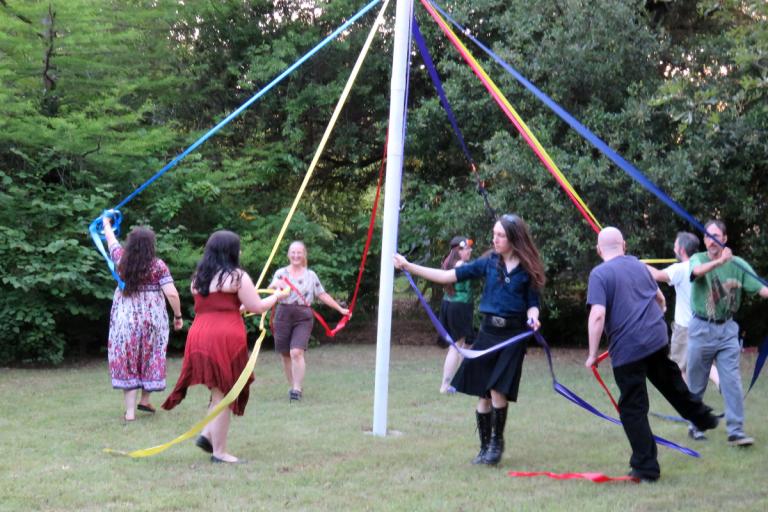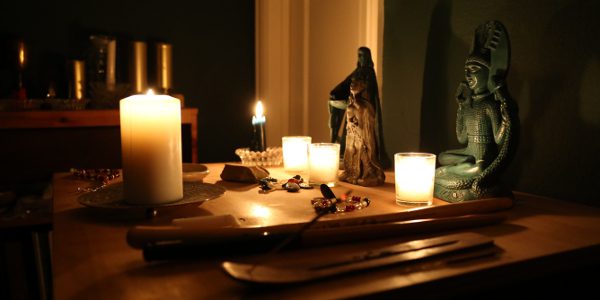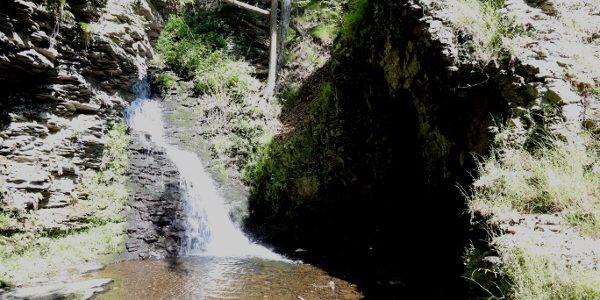 Last week The Wild Hunt ran a feature titled What Will Paganism Look Like In 100 Years? I was one of eight contributors who discussed our hopes, fears, and predictions for the future of our movement.
Last week The Wild Hunt ran a feature titled What Will Paganism Look Like In 100 Years? I was one of eight contributors who discussed our hopes, fears, and predictions for the future of our movement.
While all religions are rooted in the experiences of their founders (which may be one individual or may be an entire tribe of people), religious movements rise as they respond to human needs in an particular environment, and they fall as they cease to be relevant to their followers. Modern Paganism is a response to the abuses and excesses of the Christian church, to the separation of people from Nature, and to the separation of people from their Gods and ancestors. These conditions, which gave rise to the emergence of Paganism in the 19th century and to its explosion in the 20th century, will continue in the 21st and 22nd. Paganism will continue to grow in both breadth and depth over the next 100 years.
The question, then, is “how do Pagan leaders foster both breadth and depth?” That is, how do we appeal to ordinary people who are dissatisfied with their current religion (or lack thereof) but who aren’t interested in becoming mystics and magicians. And at the same time, how do we develop and support practices that appeal to those who are called to be mystics and magicians?
How do we foster elite levels of skill and devotion without becoming elitist?
I see far too many Pagans who want one of these but not the other. Some want to include everyone no matter what and get upset if anybody starts talking about the differences between, say, polytheism and non-theism: “what difference does it make – just dance!” And others are suspicious of growth and don’t care if their tradition has more than four members so long as they’re doing really deep work.
Growth for the sake of growth is cancer, but if a religious tradition is healthy and vibrant it’s going to attract newcomers. Let’s make room for them and let’s help them participate to the extent of their talents and desires, however small or large those may be.
Before we go any further, let’s be clear about one thing: yes, you’re a leader. If you plan and facilitate rituals for more than yourself, you’re a leader. If you talk about Pagans and Paganism in person or on social media, you’re a leader. If you wear Pagan jewelry or t-shirts, you’re a leader. You may not be an elder, or a high priestess, or a senior Druid. You may have no organizational status or responsibilities. You may be leading at a level far below that of Pagans who are generally recognized as leaders. But if your life influences others – whether you want to influence them or not – you’re a leader.
So, how do we foster both breadth and depth in our Pagan traditions?
We foster breadth by respecting religious freedom. This doesn’t mean “being nice to your Christian relatives” – though that’s usually a good idea. It means understanding and accepting that different people are called by different Gods to worship Them in different ways. It means understanding and accepting that some people aren’t called by any Gods, or they’re unable or unwilling to accept the existence of Gods and spirits.
It’s not our job to steer them toward “proper” practice. It’s our job to accept them for who they are and to judge their religion (or lack thereof) by how it inspires them to live their lives, not by how closely it matches ours. It’s our job to work with them when we have common interests, and to work separately when we’re called to do something that doesn’t match up with their practices. “Least common denominator” religion doesn’t serve anyone’s best interests.
This is leadership by example.
We foster depth by practicing deeply ourselves, and by connecting with others doing the same. If I seem to be constantly emphasizing deep spiritual practice, that’s because there’s nothing else that will build connections to the Gods, spirits, and Nature as strongly and as reliably. There are many practices and you don’t have to do them all. You probably can’t do them all – I certainly don’t. Rather than doing many things weakly, do a few things consistently. Make a conscious effort to do them as well as you can and you’ll get good at them – you’ll grow in spiritual depth.
Then find other people who are trying to do the same thing. Perhaps you find you’re the most skilled with prayer. Someone else is the most experienced with meditation. Another is the most knowledgeable about history and lore. You work together, practice together, and learn from each other… and all of a sudden, you’re all deeper together than you were separately.
Maybe this ends up becoming a grove of Druids or a college of mystics. Maybe it becomes a priesthood. Maybe you’re just a group of friends who drink tea and talk about what you do. The main thing is that you’re a collection of Pagans who want a deep practice, and you’re there for the next person who’s looking for the same thing.
This is leadership by participation.
We draw boundaries tentatively. Many Pagans have a strong bias against authority and for inclusion. But while radical inclusion has a place in our wider society, we do ourselves no favors if we naïvely insist our many diverse religious and spiritual traditions are really all the same.
Institutions have clear boundaries: if you want to be an OBOD Druid, you have to sign up for the Bardic course and start working your way through the material. You’re either in or you’re out. Roles and traditions are considerably less well defined. What’s a priest? What’s a witch? What is Irish Paganism? There are no clear definitions. My seemingly obvious statement that Polytheism is Theism drew 185 comments, many of them insisting I had no right to draw even the most basic of boundaries.
Where there are clear, natural boundaries, let’s acknowledge them. Where there aren’t, let’s draw them tentatively. Our understanding of the nature of the Gods and the definition of magic will always be incomplete. Let’s draw the boundaries that are necessary for effective practice, but let’s remain open to new thinking, new experiences, and new interpretations.
This is leadership by integrity.
We maintain boundaries compassionately. We live in the most religiously diverse and religiously fluid society in the history of humanity. We get a lot of people who pass through Paganism on their way to something else, and people who wander into the Big Tent without knowing whether they’re really called to Wicca, traditional witchcraft, OBOD Druidry, Hellenic polytheism, or some other tradition.
Neither breadth nor depth will be achieved by pushing people into practices and groups that don’t interest them or that they’re not ready to tackle. Nor will it be achieved by setting barriers so high ordinary people can’t get over them. Most people do a pretty good job of self-selecting themselves into and out of groups and traditions. Early in my Pagan exploration, I selected myself out of a Western Mystery Tradition group. They were good people doing good work, but I had no desire to learn Hebrew and work with Gods as archetypes.
Occasionally, though, leaders are forced to say “this is what we do here – you don’t seem to be committed to the same things we are.” Or, if the group was intended to be more general and inclusive, leaders may need to say “some of us are going to form a subgroup to focus on this one specific tradition.” We cannot allow a few individuals to distract a group and its members from their core purpose.
This is leadership by discernment.
The future of Paganism is bright. The factors that gave rise to the restoration and recreation of Paganism will continue for the foreseeable future. If anything, environmental concerns and the general decline of the American empire should increase the number of people who are looking for what we already have, and what we’re building.
The Pagan movement will continue to grow in breadth and depth. It falls to all of us in the Pagan community to exercise the leadership necessary to be ready for this growth.




















